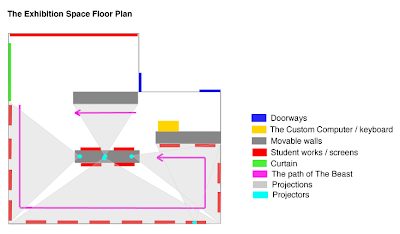avan20 Blog
Sunday, May 29, 2011
Final Word
Saturday, May 28, 2011
Costing
The exhibition space will be free for us to use. We will also have access to approximately 5 projectors and enough screens (either flatscreens or computers). However, if we need to use computers to display student works, these will need to be put on some sort of platform on the walls. In this case, we could easily mount wood on the walls to rest the computers on, allowing the creature to still climb over and under the works.
The projections themselves won’t cost any money.
The custom keyboard case will be very cheap as well and will be very easy to construct.
We can potentially use large sheets of paper to cover the surface of the greenscreen wall, but this won’t cost much either.
Here is a breakdown of all our potential costs:
| Material | Price |
| Projections | $0 |
| Exhibition Space costs (including seating, movable walls etc.) | $0 |
| Screens | $0 |
| 5 projectors | $0 |
| Platforms (potential) | $468 (Bunnings Warehouse Floating Shelf) |
| A1 Paper to cover greenscreen | $40 (art supply store, Doncaster) |
| Cardboard for custom keyboard | $20-50 depending on materials and solution chosen |
If the floating shelves and the A1 paper is required, this project will cost approximately $560.
This makes the project very feasable. If we decide that we don’t need to have platforms or the A1 paper, this project will only cost about $20-$50 for the materials required to build the custom keyboard case.
The Custom Keyboard

For example, the custom button showing a smiley face or a sun (representing happiness), can be pushed by the visitor. This custom button, when pressed, will in turn press down a keyboard button, for example, the letter “G” button, which can be programmed to set the “happy” animation into play.
As you can see, The custom buttons care built into the custom keyboard case and when pressed, will press the real keyboard buttons which will activate the code.
Monday, May 23, 2011
Exhibition Space

As you can see from the above floor plan, the viewers can enter the exhibition space from two doors. However, I think it will be more appropriate for the visitors to enter through the door near the custom computer/keyboard so that they can have access to it. The rest of the exhibition space in the main room will then encourage viewers to walk the same route as the Beast.
In the smaller room, the student works will be displayed on the big screen. We can put chairs in here to allow viewers to sit.
The greenscreen wall on the left of the above floor plan can be made white with paper pasted on top of it if need be.